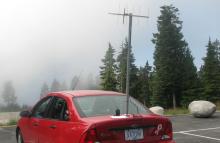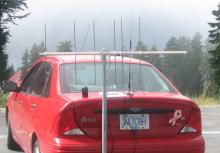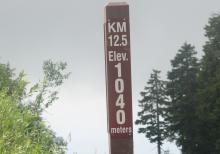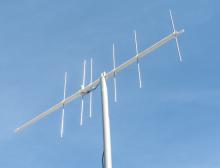Obsessed by the number 220
Stuart (VA7CRH) is getting into the 220 MHz band thanks to both Eric Kehler (VE7EGK) and an American 220 MHz repeater operator Wayne (WA6MPG).
After banging together a dual band j-pole for VHF & UHF, Stuart put together a mono-band 220 MHz j-pole so as to get the full use of his Kenwood TH-F6 tribander. Unhappy with the results, he scoured the internet for another type of antenna, and ran across 220 MHz yagis, as well as quads. He followed the plans listed at:
http://www.cebik.com/vhf/220-1.html
and the 4 element yagi went together really well. It boasts an 8.21 dBi gain in the forward direction. With the 5 watts in the Kenwood, Stuart was suddenly hitting the few repeaters in the Lower Mainland as well as about four in northwest Washington state.
The parts cost less than $20, even if Stuart is less than proficient in soldering.
Undaunted, he ran across some low-cost quarter inch steel bar at Princess Auto in Langley. It took about an hour to take the 4 element one apart and fashion the 6 element yagi seen in the photo. It sports a 10.22 dBi forward gain.
As further pictured, Stuart then went up to the 3,400 feet level at Mount Seymour in North Vancouver. He had a number of pleasant QSOs on this supposedly "unused" VHF band. What follows is a comprehensive list of the 220 MHz repeaters that can be hit from there with 5 watts and a yagi.
223.940 - Sultan (tone 123.0) on Haystack Mountain, Washington
224.120 - Puget Sound, Washington
224.240 - Capital Hill, Washington (103.5) N7NFY
224.280 - Everett, Washington (103.5) K5IN
224.340 - Seattle, Washington K7NWS
224.480 - Seattle, Washington K6LIE
224.540 - Orcas Island, Washington (67.0) WA6MPG
224.760 - Puget Sound, Washington (103.5)
224.780 - Puget Sound, Washington (103.5) N7IPB
224.880 - Maple Ridge, BC VE7RMR
224.960 - Burnaby, BC VE7VYL
224.920 - (Unknown)
Others seem to be able to work the two Victoria 220 MHz repeaters as well as one in Coquitlam, but Stuart was unable. All in all about 40 listed repeaters from various sources were checked.
What's next? Well, 4 element quads look like a lot of fun, and an Alinco DR235 220 MHz transceiver is probably in the cards. The test above can then be repeated with 25 watts. There's also something called a "Quagi", a combination of the two directional antennae.
Putting them together is easy and fun.... especially with the java-script powered calculators on the net. Try out:
http://www.softcom.net/users/kd6dks/quad.html or:
http://signalengineering.com/ultimate/4_element_quad.html for quad antennae and:
It's easier than it seems. Try it!
Here are a few pictures of my adventures - click on the image for a larger view




